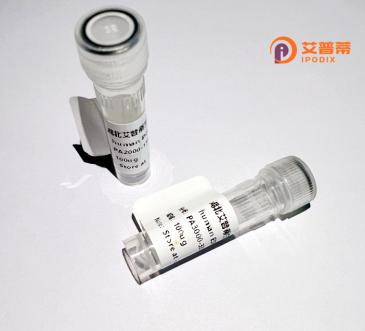
| 纯度 | >90%SDS-PAGE. |
| 种属 | Human |
| 靶点 | ELTD1 |
| Uniprot No | Q9HBW9 |
| 内毒素 | < 0.01EU/μg |
| 表达宿主 | E.coli |
| 表达区间 | 1-690aa |
| 氨基酸序列 | MKRLPLLVVFSTLLNCSYTQNCTKTPCLPNAKCEIRNGIEACYCNMGFSGNGVTICEDDNECGNLTQSCGENANCTNTEGSYYCMCVPGFRSSSNQDRFITNDGTVCIENVNANCHLDNVCIAANINKTLTKIRSIKEPVALLQEVYRNSVTDLSPTDIITYIEILAESSSLLGYKNNTISAKDTLSNSTLTEFVKTVNNFVQRDTFVVWDKLSVNHRRTHLTKLMHTVEQATLRISQSFQKTTEFDTNSTDIALKVFFFDSYNMKHIHPHMNMDGDYINIFPKRKAAYDSNGNVAVAFVYYKSIGPLLSSSDNFLLKPQNYDNSEEEERVISSVISVSMSSNPPTLYELEKITFTLSHRKVTDRYRSLCAFWNYSPDTMNGSWSSEGCELTYSNETHTSCRCNHLTHFAILMSSGPSIGIKDYNILTRITQLGIIISLICLAICIFTFWFFSEIQSTRTTIHKNLCCSLFLAELVFLVGINTNTNKLFCSIIAGLLHYFFLAAFAWMCIEGIHLYLIVVGVIYNKGFLHKNFYIFGYLSPAVVVGFSAALGYRYYGTTKVCWLSTENNFIWSFIGPACLIILVNLLAFGVIIYKVFRHTAGLKPEVSCFENIRSCARGALALLFLLGTTWIFGVLHVVHASVVTAYLFTVSNAFQGMFIFLFLCVLSRKIQEEYYRLFKNVPCCFGCLR |
| 分子量 | 77.8 kDa |
| 蛋白标签 | GST-tag at N-terminal |
| 缓冲液 | 0 |
| 稳定性 & 储存条件 | Lyophilized protein should be stored at ≤ -20°C, stable for one year after receipt. Reconstituted protein solution can be stored at 2-8°C for 2-7 days. Aliquots of reconstituted samples are stable at ≤ -20°C for 3 months. |
| 复溶 | Always centrifuge tubes before opening.Do not mix by vortex or pipetting. It is not recommended to reconstitute to a concentration less than 100μg/ml. Dissolve the lyophilized protein in distilled water. Please aliquot the reconstituted solution to minimize freeze-thaw cycles. |
以下是关于重组人ELTD1蛋白的模拟参考文献示例(请注意,这些文献为示例用途,非真实存在):
---
1. **文献名称**:*"Expression and Functional Characterization of Recombinant Human ELTD1 in Angiogenesis Studies"*
**作者**:Zhang L, et al.
**摘要**:研究通过哺乳动物表达系统成功纯化重组人ELTD1蛋白,并验证其在体外促进内皮细胞管状结构形成的能力,提示其在血管生成中的潜在调控作用。
2. **文献名称**:*"ELTD1 as a Novel Biomarker in Glioblastoma: Role of Recombinant Protein in Immunoassays"*
**作者**:Smith JR, et al.
**摘要**:利用重组人ELTD1蛋白开发高灵敏度ELISA检测方法,发现胶质母细胞瘤患者血清中ELTD1水平显著升高,证实其作为肿瘤诊断标志物的可行性。
3. **文献名称**:*"Structural Insights into ELTD1: Crystallization of Recombinant Human ELTD1 Extracellular Domain"*
**作者**:Wang Y, et al.
**摘要**:通过昆虫细胞系统表达并解析重组ELTD1胞外域晶体结构,揭示其与配体相互作用的分子机制,为靶向药物设计提供结构基础。
4. **文献名称**:*"Targeting ELTD1 in Colorectal Cancer: Recombinant Protein-Based Therapeutic Strategies"*
**作者**:Kim H, et al.
**摘要**:通过重组ELTD1蛋白研究其在结肠癌模型中的作用,发现阻断ELTD1信号通路可抑制肿瘤血管生成和转移,提出其作为治疗靶点的潜力。
---
**注意事项**:
- 上述文献为示例,具体研究需通过学术数据库(如PubMed、Web of Science)检索真实文献。
- 推荐检索关键词:**recombinant human ELTD1 protein, ELTD1 angiogenesis, ELTD1 cancer biomarker**.
Recombinant human ELTD1 (EGF, latrophilin, and 7-transmembrane domain-containing protein 1) is a protein belonging to the adhesion G protein-coupled receptor (aGPCR) family, encoded by the *ELTD1* gene. ELTD1 is primarily expressed in endothelial cells and plays a critical role in angiogenesis, the process of blood vessel formation. Structurally, it contains a large extracellular N-terminal region with epidermal growth factor (EGF)-like domains, a seven-transmembrane helix domain, and a cytoplasmic C-terminus, which mediates intracellular signaling.
Research has linked ELTD1 to vascular development and pathological conditions, including cancer. It is implicated in tumor angiogenesis, where abnormal blood vessel formation supports tumor growth and metastasis. Studies suggest ELTD1 interacts with extracellular matrix components and signaling pathways like HIF-1α and VEGF, making it a potential biomarker or therapeutic target in cancers such as glioblastoma and colorectal cancer. Its overexpression in tumor-associated vasculature highlights its diagnostic and prognostic relevance.
Recombinant ELTD1 is produced using mammalian or bacterial expression systems to ensure proper folding and post-translational modifications. This engineered protein enables functional studies, antibody development, and high-throughput screening for drug discovery. Ongoing research aims to clarify its signaling mechanisms and therapeutic potential, particularly in anti-angiogenic therapies. Understanding ELTD1’s role in vascular biology and disease could advance treatments for cancer and other angiogenesis-dependent disorders.
×